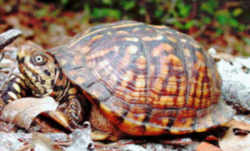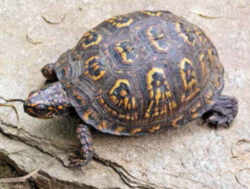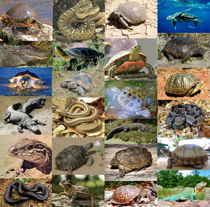
North Carolina Symbols
North Carolina State Reptile and Emblem
Eastern Box Turtle

(Terrapene carolina)
Adopted in 1979.
The General Assembly of 1979 designated the Eastern Box Turtle, (Terrapene carolina,) as the official State Reptile for North Carolina. (Session Laws, 1979, c. 154).The eastern box turtle is terrestrial, meaning it lives on land, and is most commonly found in and near wooded areas. These turtles' high domed top shells and hinged bottom shells allow them to completely close their shells for protection when predators are on the prowl.
Eastern box turtles hibernate in winter and the females typically lay their eggs in June and July. These turtles can live longer than 50 years! While still common in many areas, the eastern box turtle population has declined, partly due to human activity, including being caught as pets and the destruction of its natural habitats.
North Carolina State Reptile
and Emblem:
Eastern Box Turtle

The box turtle (Terrapene Carolina Carolina) gets its name from its hinged plastron that allows it to close tightly against the carapace for protection. The upper shell is very dome-shaped with a ridge and comes in a variety of colors such as tan, dark brown, yellow, orange or olive. The shell can have no design but often has a block pattern or blotching. A simple identification between male and female is that males have red eyes, while female eyes are yellow-brown.
This peaceful creature usually reaches a length of less than six inches. This reptile usually lives between 30 to 60 years and never ventures far from its place of birth. Hibernates in late October or early November by burrowing into loose soil or pond bottom.
The turtle is one of nature's most useful creatures. Through its dietary habits it serves to assist in the control of harmful and pestiferous insects and as a clean-up crew, helping to preserve the purity and beauty of our waters. At a superficial glance, the turtle appears to be a mundane and uninteresting creature; however, closer examination reveals it to be most fascinating, ranging from species well-adapted to modern conditions to species which have existed virtually unchanged since prehistoric times. Derided by many, the turtle is really a culinary delight, providing the gourmet food enthusiast with numerous tasty dishes from soups to entrees.
The turtle watches undisturbed as countless generations of faster "hares" run by to quick oblivion, and is thus a model of patience for mankind, and a symbol of our State's unrelenting pursuit of great and lofty goals.
This peaceful creature usually reaches a length of less than six inches and has a shell of black or brown with spots of yellow, orange and red. This reptile usually lives between 30 to 60 years and never ventures far from its place of birth. Hibernates in late October or early November by burrowing into loose soil or pond bottom.
Description of the Eastern box turtles
Eastern box turtles are easily recognized. These terrestrial turtles may reach 8 inches (20 cm) in length (Ernst and Barbour, 1989; Smith and Brodie, Jr., 1982). The carapace is high, dome-shaped, and has a low keel. The color of the carapace is brown, black, tan, or olive and usually has a variable pattern of bright yellow or orange blotches or radiating lines. Concentric growth rings appear on the shells of many younger individuals. These rings wear with age and older turtles often have smooth shells (Schwartz et al, 1984). The plastron is olive, tan, or brown. It is often smudged with black. A single hinge runs across the plastron. This adaptation enables a box turtle to withdraw its head and limbs and close its shell tightly for protection. The front legs are heavily scaled. The skin is black, reddish brown, tan, or grey. The sides of the head and neck are marked with yellow and orange spots or lines. The upper jaw is hooked at the end and without a notch. Although there are variations and exceptions, male and female box turtles can usually be distinguished by several secondary sexual characteristics. The plastrons of most males are concave, while those of females are flat and may have slightly convex edges (Schwartz et al, 1984). The male's tail is generally longer and thicker with the anus placed farther back than the female's. A slight bulge at the base of the tail may also be observable in males (Schwartz et al, 1984). The male is larger (de Vosjoli, 1995), and has enlarged, curved claws on the hind feet. The eyes of females are grayish-brown, yellowish, or dark red. Eyes of adult males are usually brighter, often a bright red.
Behavior:
Eastern box turtles are diurnal. During the day, T. carolina forage for food, search for mates, and explore their territory. At night, they rest in shallow forms that they scoop out at dusk. Box turtles are unable to tolerate high temperatures and in the summer are most active in the morning or after periods of rain. During the midday, box turtles become less active and seek shade. Also, they will bury into rotten logs, leaf piles, or mud to avoid the heat. Eastern box turtles can retain water better than aquatic turtles. This allows them to cope with short dry spells. They survive longer periods of drought by burying into logs or mud. During the cooler temperatures of spring and fall, box turtles are more active. At these times, they can be found moving around their territory at any daytime hour.
In the northern part of its range, the Eastern box turtle enters hibernation in October or November. In the south, a box turtle may remain semiactive throughout the winter. During cold snaps, the box turtle will slow down, but will not become truly dormant. For its hibernacula, the box turtle buries into loose soil, leaf litter, mud, sand, logs, or animal burrows. Frequently, box turtles can found hibernating in the same area with other turtles. Through the winter, as the soil temperature drops, the box turtle buries deeper. They often dig up to two feet deep (Ernst and Barbour, 1972). During spring warm spells, box turtles will awaken and leave their burrows. Dropping temperatures often kill many of them by catching them before they can return to their hibernacula. Box turtles usually emerge for good in April, after the danger of freezing temperatures has past.
Geographic Range:
Terrapene carolina triunguis (3 toed Box Turtle) lives in the Mississippi River Valley from northern Missouri southward across southeastern Kansas and eastern Oklahoma into south-central Texas; and southeastward across western Tennessee and Georgia to the coastal lowlands. Terrapene carolina carolina (Common Box Turtle), covering the largest area, lives from Michigan and Maine on the north, and ranges south to the boundaries of the other subspecies. Very little overlap occurs between the ranges of the subspecies of T. carolina , except for a region in Mississippi and Alabama where T. carolina triunguis and T. carolina carolina overlap
Diet:
Omnivorous, T. carolina eats snails, insects, berries, fungi, slugs, worms, roots, flowers, fish, frogs, salamanders, snakes, birds, and eggs indiscriminately. They have been observed eating carrion, feeding on dead ducks, amphibians, assorted small mammals, and even a dead cow. Their preference varies greatly by season but there is one definite trend. Young are primarily carnivorous while they grow during their first 5-6 years. Adults tend to be mostly herbivorous, but they eat no green leaves. Young often hunt in ponds and streams because the type of food they prefer is easier to catch there, but adults usually feed on land.
Habitat:
Habitat consists primarily of open woodlands, but the eastern box turtle can be found in pastures and marshy meadows, and in Florida may be found in palmetto thickets. Reagan (1974) reported a seasonal shift in habitat from grasslands (late spring and early fall) to forested areas (summer, early spring, and late fall).
Reproduction:
The mating season begins in the spring and continues throughout summer to about October. Males may mate with more than one female, or the same female several times over a period of several years. A female may lay fertile eggs for up to four years after one successful mating. Nesting occurs from May through July. Most nests are started at twilight and finished during the night. Nests are usually dug in sandy or loamy soil, using the hind legs. Then eggs are laid in this cavity and the nest is carefully covered up again. There are 3-8 eggs laid, though usually 4 or 5, and they are elliptical with thin, white, flexible shells roughly 3cm long by 2cm wide. Incubation normally last three months, but this varies according to soil temperature and moisture. Terrapene carolina exhibit temperature dependent sex determination. Nests that are 22-27 degrees C tend to be males, and those above 28 degrees tend to be female. Terrapene carolina are well developed at birth (precocial) and grow at a rate of about 1.5cm per year during the first five years, at which time they reach sexual maturity. Growth slows down considerably after that but has been reported to continue for at least over 20 years. Some T. carolina are believed to live over 100 years.
North Carolina Law
The law designating the turtle as the official North Carolina state reptile is found in the North Carolina General Statutes, Chapter 145 Section 145-9.
Chapter 145.
State Symbols and Other Official Adoptions.
§ 145-9. State reptile. The turtle is adopted as the official State reptile of the State of North Carolina, and the eastern box turtle is designated
as the emblem representing the turtles inhabiting North Carolina. (1979, c. 154, s. 1.)
Taxonomic Hierarchy: Turtle
Kingdom: Animal
Phylum: Chordata
Subphylum: Vertebrata
Class: Reptilia
Order: Testudines
Family: Emydidae
Genus: Terrapene
Species: Terrapene carolina







